The beautiful and exotic emperor angelfish, also known by their scientific name, Pomacanthus imperator, is native to tropical waters near Hawaii. They are found in that area, but their species span East Africa, the Red Sea, and even down to Australia! They are a populous species that has a very stable count.

As many Pixar cartoons may have depicted them, the Pomacanthus imperator angelfish is commonly found near beautiful coral reefs in the wild. Their unique stripes and coloration make them very popular in the aquarium trade. Just looking at their unique dark blue, black, and bright yellow exterior, we are anxious to share more with you about the emperor angelfish.
Table of Contents
Emperor Angelfish: Overview
| Information Chart | Emperor Angelfish |
|---|---|
| Scientific Name: | Pomacanthus imperator |
| Family: | Pomacanthidae |
| Care Level: | Medium |
| Temperament: | Semi-aggressive |
| Color: | Bright hues of yellow, dark blue, white, black, and a bit of indigo |
| Lifespan: | Over 20 years |
| Size: | Around 12″ |
| Diet: | Omnivorous |
| Minimum Tank Size: | 125 gallons |
| Temperature: | 72-82 ºF, 22-28 ºC |
| Water Conditions: | the pH of 8.1-8.4 (more alkaline) and gravity of 1.023-1.025 |
| Tank Mate Compatibility | Low |
Emperor Angelfish Appearance
Perhaps the most interesting thing about the emperor angelfish Pomacanthus imperator is their appearance. Some inexperienced aquarists may believe that there are different species of emperor angelfish. Still, they will be surprised to learn that the angelfish emperor Pomacanthus imperator they see is the same one. This species evolves drastically in appearance during each life stage.
Color
They are known to display bright hues of yellow, dark blue, white, black, and a bit of indigo. Of course, this all depends on their life stage. Let’s take a closer look at these amazing changes.
Juvenile emperor angelfish are the most beautiful in our opinion. They sport cold colors and have vertical lines and wavy patterns on their bodies and faces. Their base color is dark blue or black with light blue and white stripes. The emperor angelfish juvenile will also have spots on the dorsal to anal fins.
Once they get slightly older and mature to sub-adults, you can see a yellow hue start to develop on their tail fin. This yellow will slowly creep onto their bodies to transform them into adult forms. The once curved bands on their body will also slowly change and take shape into stripes across its body.
Adult emperor angelfish Pomacanthus imperator will have yellow and blue stripes across its body with a fully yellow tail fin. It will also have a predominantly white face with a dark blue or black band across its eyes and other dark blue markings.
Since you can almost say that a fish’s development in captivity is stunted, all this color-changing will take longer than it would in the wild. Also, the coloration of captive emperor angelfish Pomacanthus imperator is less vivid in captivity, but that can be solved with color brighteners.
Varieties Of Emperor Angelfish
They are classified into three stages: juvenile emperor angelfish, sub-adult angelfish, and adult angelfish.
Juvenile Emperor Angelfish
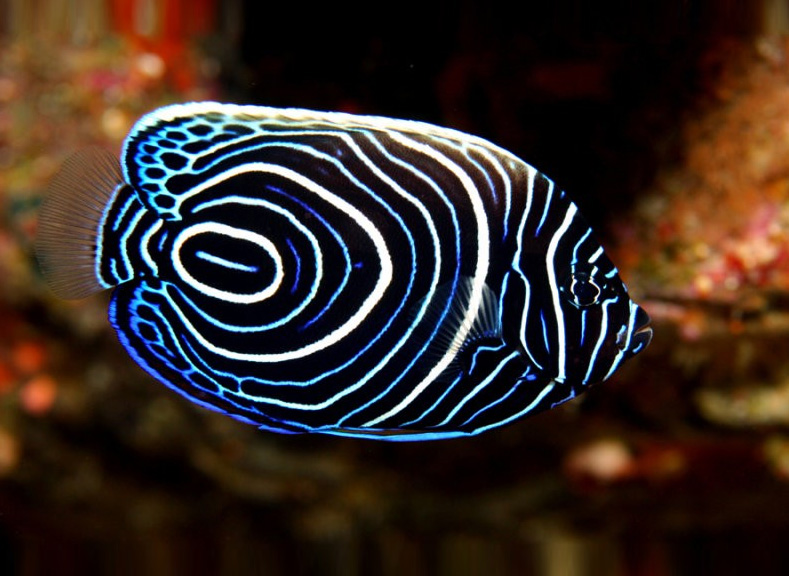
Sub-Adult Angelfish
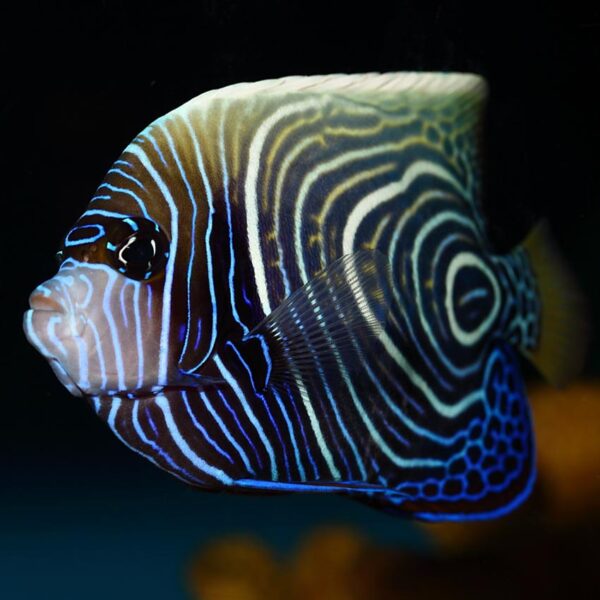
The Lifespan Of Emperor Angelfish
You will be pleased to know that the emperor angelfish has a very long lifespan of over 20 years in the wild! In captivity, this number is lessened to 15-18 years. Since they do come with quite a high price tag (even though they are common in the aquarium trade), they are a good investment since they can keep you company for a long time.
Emperor Angelfish Size
How big do emperor angelfish get? The emperor angelfish Pomacanthus imperator can be as large as 15 inches in the wild. However, like most other fish, they are a bit smaller in captivity, getting up to about 12 inches.
Natural Habitat And Origin
The emperor angelfish is from the Pomacanthidae family and is a saltwater fish found in tropical waters worldwide.
Emperor Angelfish can be found all over the coast of East Africa, from the Pacific to the Indian Oceans. They can be found in Hawaii, the Austral Islands, and the Red Sea worldwide. Some places like the Great Barrier Reef and southern Japan have seen them and New Caledonia and Florida in the United States.
They have been reported invading the southeast Mediterranean through the Suez Canal in the last few years. Most likely, they were invading.
Emperor Angelfish Care & Tank Set-Up
Care Level
The angelfish Pomacanthus imperator is a saltwater fish that needs moderate care. This is attributed to their need for certain water conditions that may be hard to maintain, and they need lots of room since they can get pretty big. Getting them into your aquarium is tough because they do not travel well and are prone to stress.
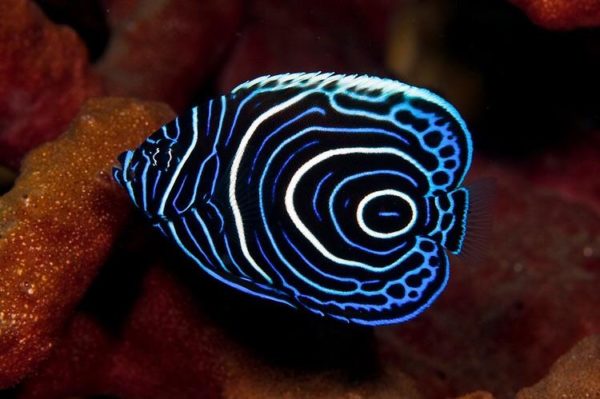
Picking the right one at the beginning will help lower the risks you may encounter with your Pomacanthus imperator angelfish. Are emperor angelfish reefs safe? Many aquarists ask this question since they are closely related in the wild. However, the surprising answer is that they are not.
Maintenance and Care
They need to be introduced into established aquariums, so you need to have the tank set up before bringing your angelfish home. It also needs to be completely cycled, and you should clean the water regularly. It needs to be done as often as once per week or every two weeks slowly. Starting from 10-15% with the same amount being cycled every time.
They are beautiful fish, but the emperor angelfish does require a more than average amount of your attention to thrive in captivity.
Emperor Angelfish Tank Size And Specifications
Since they are found in many parts of the world, you think an emperor angelfish can tough out different water conditions. However, they are surprisingly less hardy than many other saltwater species. Another interesting point about emperor angelfish is they seem to be three different fish rolled into one.
Aside from their distinct color changes throughout their maturing phase, they also change their habitats. Juvenile emperor angelfish can be found in rocks near the reef, but the sub-adults move closer into the reefs. When they mature into full-fledged adults, they gravitate more towards coral. Make sure you include lots of rockwork when decorating your aquarium.
Raising your angelfish from the juvenile (mostly blue) stage is always recommended. This will give them enough time to adjust to aquarium life and acclimate to food in captivity. Another feature that this species requires is adequate sunlight. To be 100% healthy, place the tank in an area with sufficient light. This will decrease the chances of diseases and help their coloration as well.
Because they eat a lot, they have a large bioload.
For this reason, we suggest purchasing a reliable water filter. Not only will this filter be responsible for keeping the water clean, but it will also produce slow currents that the angelfish is used to. Plants can be kept in the tank, but although they are used to reefs in the wild, we don’t recommend them in the aquarium, and this is because they will start nipping at them.
Optimum Tank Size For Emperor Angelfish
To give them the best chance in captivity, you need to do your best to replicate their natural environment. They are used to having lots of space and can be territorial, so you’re looking at a minimum aquarium size of 125 gallons for just one emperor angelfish and over 180 gallons for a pair.
Tank Shape For Emperor Angelfish
Emperor Angelfish needs such a large tank because they require regular feeding, which increases the bioload of the aquarium. Before adding any Angelfish to your tank, make sure it has been properly cycled and set up for at least six months.
Filter Type
Go for a good filtration system for the tank as they can produce a lot of dirt and debris.
As a consequence, the filter should be able to cycle the tank and maintain proper levels.
Substrate
Includes a lot of live rock for the fish to eat and places where the fish can hide. This will make the fish feel more at home. They need a lot of places where they can swim and places where they can hide.
How Many Emperor Angelfish In A 180-Gallon Tank
A pair of juvenile Emperor Angelfish
Water Parameters For Emperor Angelfish
The water quality should be maintained quite precisely. The emperor angelfish will thrive with a pH of 8.1-8.4 (more alkaline) and a gravity of 1.023-1.025. Keep the water slow-flowing or still just like their regular environment.
Water Temperature
The temperature of the aquarium is best kept at 72-82oF (22-28oC), as they are more accustomed to warmer waters.
Water Flow Rate
Emperor Angelfish can endure any flow rate.
Slow-moving water, on the other hand, appeals to them.
Ph Level
8.1-8.4
Emperor Angelfish Tank Landscape
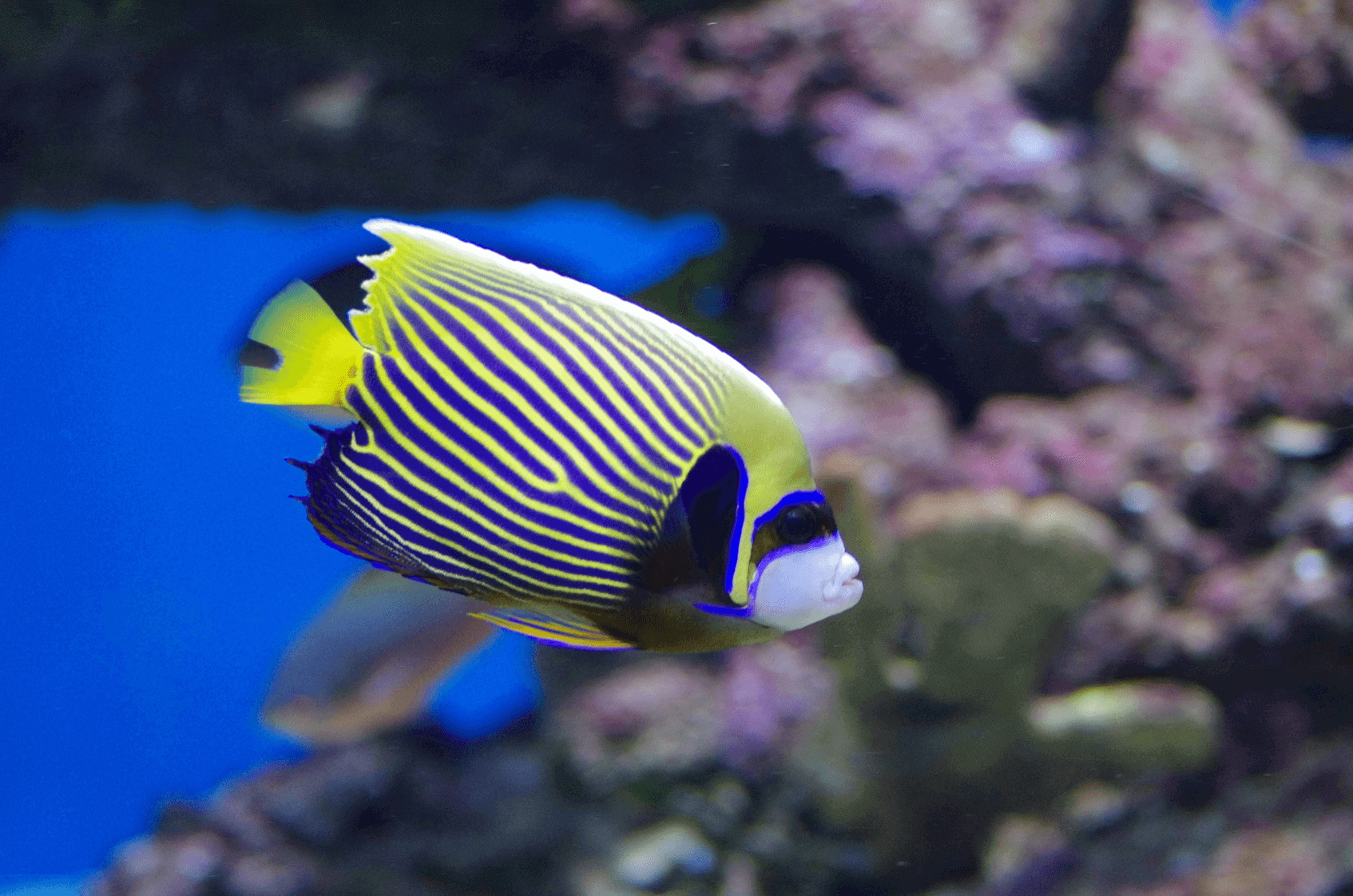
Best Plants For Emperor Angelfish Tanks
Having a lot of coral is also a wonderful idea.
However, you must exercise caution while selecting coral kinds for your aquarium. Both hard and soft coral has been seen consumed by this species. Stony corals with small polyps, bubble corals, disc anemones, hammer corals, and star polyps are excellent options.
Worst Plants For Emperor Angelfish Tanks
Although finding suitable Angelfish neighbors might be challenging, it is advised that you introduce your fish to a community tank to reduce their first hostile tendencies.
Decorations For Emperor Angelfish Tanks
Include plenty of live stones for the fish to eat, as well as hiding spots to make the fish feel at ease. They need a large number of open swimming areas and hiding places.
Lighting For Emperor Angelfish Tanks
Lighting may also aid with Head and Lateral Line Erosion Disease. Water quality is crucial for this species since it is sensitive to disease.
Feeding Emperor Angelfish
As mentioned, the emperor angelfish isn’t the easiest to take care of, partly due to their pickiness in the diet. When you first introduce your emperor angelfish to your new tank, chances are it will not want to eat. However, as it acclimates to the environment, things will get better.
You need to give it the chance to forage for its food.
Ensure they have enough to eat when they are first welcomed to their new home. Feeding sessions up to 5 times a day may be necessary. The actual food they are willing to eat is quite easy to handle because they are omnivores (both plant and meat diet), they have a more diverse diet.
Just make sure you feed them a good and balanced meal that consists of veggies, meat, and sponge materials. Their diet in the wild is exceedingly difficult to mimic in captivity, and the best you can do is mix tunicated hydroids with algae. They are cleaner fish so that they can take care of the algae aspect independently.
Feeding sponge materials can rack up the price of the emperor angelfish, so a good substitute would be a steady supply of live and frozen foods. Think about veggies and shrimp five times a day. When your emperor angelfish gets better adjusted to the new surroundings, you can decrease feeding to about three times a day.
Best Diet For Emperor Angelfish
Consider a balanced diet including all or most of the following:
- Algae
- Flake food
- Brine shrimp
- Squid
- Mussels
- Spinach
- Hydroid
- Krill
- Mysis
How Often Should You Feed The Emperor Angelfish?
When they feed, the emperor angelfish also tend to become more aggressive. Since you need to feed them so many times when they are first introduced, it’s important to ensure enough food to go around. This way, they will have less of a chance to be aggressive if enough to be had.
Overfeeding your emperor angelfish is also a risk. To find out just how much to give them, watch how much food they can finish within a 5 min time frame or even less. This will be a good gauge for how much they need, and then you will just have to factor in the portions for the other species.
Make sure that you clean up after them. The number one reason for soiled water quality is leftover food that isn’t properly removed. As mentioned, although they aren’t as vividly hued as they would be in the wild, a symptom of a poor diet includes faded colors.
Emperor Angelfish Behavior And Temperament
Emperor Angelfish are hard to keep also due to their temperament and behavior. The males can be aggressive and territorial, needing a lot of space. They tend to be aggressive towards other fish that look similar to themselves, such as other angelfish and ones of a similar shape.
They also do not like other fish as brightly colored as they are and tend to target them as well. Smaller fish in the same tank with the emperor angelfish is not a good idea because they bully and harass them. When you place them in reef tanks, it has been recorded that the emperor angelfish Pomacanthus imperator will nip at the coral, which makes it a bad idea.
They are first timid, but they can get quite active around the tank when they get used to their surroundings. The Pomacanthus imperator even makes noises that come in a low grunting sound when they feel their territory is encroached on or threatened.
In nature, these fish often venture out alone or in groups of one male and two or more females. The males of the species do not play nice with each other in terms of aggression.
Are Emperor Angelfish Loner Or Societal In Nature?
To minimize territorial behavior from the angelfish, introduce them to the tank last. That way, it will make it seem like all the territories have been claimed by other species first. This will make the emperor angelfish, more humble, and less aggressive.
Emperor Angelfish Tank Mates
Keeping one emperor angelfish per tank is recommended, but we understand if most people cannot resist the beauty of these exotic fish. In this case, having two is suggested, but you would need a lot of room as a 180-gallon tank is a minimum for a pair. If you get a pair, we suggest getting a male and female as males are less aggressive towards their counterparts if they are of the opposite sex.
Ideal Emperor Angelfish Tank Mates
The best tank mates would be smaller (but not by too much) and aggressive fish or larger semi-aggressive fish. Some suitable aquarium buddies for the Pomacanthus imperator include:
- Butterflyfish
- Clownfish
- Damsels
- Lionfish
- Groupers
- Pufferfish
- Tangs
- Rabbit snails
Bad Tank Mates For Emperor Angelfish
Do not keep smaller fish with them as they can be subject to their bullying, and anything small enough that can fit into an emperor angelfish’s mouth is considered to be food. The fish you place with this exotic species should not resemble them in color or shape. Other than different angelfish, the Pomacanthus imperator doesn’t take well with those similar to it.
Breeding Emperor Angelfish
They are surface spawners, which can be hard to do in captivity. This gives their spawn the best chance at survival when their eggs are scattered all over. They usually spawn once a year, and it takes the eggs about two weeks to develop into fry.
Emperor Angelfish Breeding Level
As for breeding, there has yet to be a successful one recorded in captivity. Unfortunately, if you plan on breeding your emperor angelfish, you may be in over your head.
Emperor Angelfish Sexual Dimorphism?
You can distinguish the male from female due to a small difference in their coloration. Females are less colorful and vibrant, and the males are slightly larger.
Emperor Angelfish Common Diseases And Their Treatment
Marine Velvet
Marine Velvet is a parasitic infection. Gold-colored spots form on the body when skin flagellate gets infected. It gets its name from the fact that it looks like velvet.
Finally, there’s HLLE or Hole-in-Head Disease. Although the exact cause of this illness is unclear, it is assumed that providing adequate light to Emperor Angelfish will help them avoid it.
The best way to avoid these ailments is to keep an eye on tank conditions. Stress or parasites in the water trigger the illness. Maintaining conditions and keeping the fish happy may be all it takes to avoid serious health issues.
Do a 15 percent water change every fortnight. Only make 10% modifications to avoid inflicting harm if your tank contains coral.
Facts About Emperor Angelfish
- Emperor angelfish have been seen off the coast of Hawaii, and they may be found on coral reefs across the Pacific and Indian oceans.
- The emperor’s angelfish may grow up to 15 inches long.
- According to reliable sources, the emperor angelfish has no known predators; however, larger fish, sharks, and marine animals are likely to eat it.
- The emperor angelfish is classified as Least Concern on the IUCN Red List.
- This omnivorous fish eats small insects as well as vegetation. Its favorite foods are sponge and algae.
Is Emperor Angelfish Right For You?
Aside from the price tag, a lot of effort in caring, and the space you would need, emperor angelfish are quite the trophy inhabitants of a tank for an aquarist.
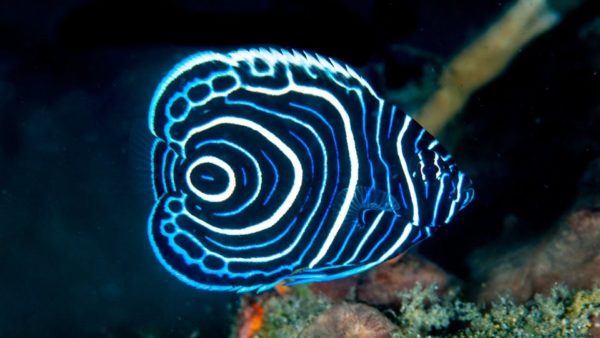
The Emperor Angelfish will be a great addition to your saltwater aquarium if you’re looking for a fish with many colors and interesting patterns.
Because they are semi-aggressive, they should be the last fish you add to your aquarium. To do this, make a list of all the fish you want. This way, you can ensure they are all compatible and in the right order.
FAQs
When It Comes To Emperor Angels, How Rapidly Do They Grow?
Under the correct conditions, a 2″ juvenile French angel might grow to 10″ in 12 to 18 months. Others, such as magnificent or royal angels, might take up to 5 years to reach 6-7″ in size from the juvenile stage, even in the correct environment.
Emperor Angelfish Has A Long Life Span.
Emperor angelfish have a longer life span. In captivity, they may live for 15 to 18 years, while they live around 20 years in the wild.
Angelfish, Do You Believe They Have Teeth?
The jaws of a huge angelfish may expand up to a couple of inches. In addition to a protruding jaw, they have an extra joint in their lower jaw that can bite while their jaws are extended.
Conclusion
If you keep a saltwater aquarium and would love to add a bit of color and exoticness to your tank, the emperor angelfish is an amazing candidate. However, since they are not the easiest to care for, we would dissuade beginner aquarists from raising them.
You need a lot of space and care to make sure your emperor angelfish will thrive in the aquarium, and they are much less forgiving with changes in water conditions. Since they should be the last ones to grace your tank, you need to do extra research into which fish would be compatible with tank mates before purchasing one.
